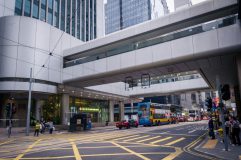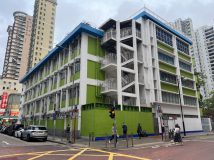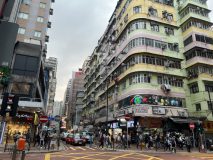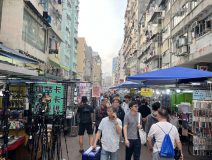Link to podcast here in case the playlist doesn’t work: https://youtu.be/sPnRqmZ_QUU
P: Patrick
J: Justin
P: Infernal Affairs is a Hong Kong crime thriller film released in 2002, directed by Andrew Lau and Alan Mak. The film’s architecture and setting play a significant role in shaping the atmosphere and overall impact of the movie. The film’s story revolves around a mole in the police department (Lau Kin Ming) and an undercover cop (Chan Wing Yan).
J: The first location we’d like to talk about is set in Apliu Street, Sham Shui Po. In this scene, the two protagonists first come across each other in an audio store on Apliu Street, where Chan works at. Apliu Street is famed for its electronics, audio equipment, and digital products stores. The film shows a high-angle wide shot of the busy streets of Apliu Street and the many flea markets taking up most of the space on the street. In current day Apliu Street, there hasn’t been much change to the appearance of Apliu street. The flea market and crowd remain almost unchanged, with the audio store in the film still in business. One point to note is the density of advertisement signs has decreased because of safety regulations imposed over the years.
P: At the first climax of the film, Triad boss Hon Sam scheduled a drug deal in the Pak Cheung Building (41 Fa Yuen Street, Mong Kok). Here, Superintendent Wong Chi Shing k the operation to bust the triad boss. In the film, it first shows a high-angle shot of Fa Yuen Street at night, where many neon signs can be seen, contrasting with the unlit Pak Cheung Building, reflecting the underground nature of the criminal operations. Pak Cheung Building has since been refurbished and painted over, as seen in the current day photo. We can also notice the decrease in the density of neon signs, with only a few left compared to the cluster of signs as seen in the film, likely due to light pollution to nearby residential areas. On the other side of the street is GT College, where Superintendent Wong requisites to set up the base for his operation and survey the ongoings of the Pak Cheung Building. In the film, it uses the inside of the classroom, which was dimly lit as the operation room, and Inspector Lau looks across to the other side from the school.
J: The street landscapes plays an essential role in the film, creating a sense of claustrophobia and entrapment for the characters. Sham Shui Po and Mong Kok both has a complex network of narrow streets and high-rise buildings. The maze-like structures of the buildings reflect the labyrinthine nature of the criminal underworld and the complexities of the dual identities of the two main characters, who work as moles for the police and the triads.
Furthermore, the architecture also reflects the themes of duality and duplicity throughout the film. The buildings and structures of Hong Kong often have two faces, with their external facades presenting one image, while their interiors and back alleys hide their true nature, such as the weatherbeaten exterior of the building in Apliu Street and the upmarket interior of the audio store. This mirrors the two main characters, who must navigate their dual identities as moles while maintaining their cover.
P: Chan, seeking therapy, meets the psychiatrist Lee. Over time, he developed subtle feelings while getting along. Chan finally told Lee the secret of being an undercover agent. There are two scenes in the film about Yan going to the clinic. The filming location is near the head office of Hang Seng Bank in Connaught Road Central, Central. In the film, this space is depicted as almost peaceful and quiet, in stark contrast to the character’s high-stakes life as an undercover cop.
In real life, the space around Hang Seng Bank on Connaught road is always bustling and somewhat difficult to navigate. Between the towering skyscrapers and the fact that you cannot walk across the roads – you must use the footbridges to get across – it took me quite a while to get around the whole building and take multiple pictures. It is unique in that the ground floor of the buildings is often scalloped inwards from the sidewalk, greatly increasing the area for pedestrians. This has the notable effect of giving people a “safe space” to talk, as foot traffic is concentrated on the sidewalk, and people can just step out of the flow of traffic and onto the raised podium to converse or just to take a break from walking. I think this location was chosen masterfully because it not only aligns with the real life facts that there are many clinics and office spaces in central, but also the difficulty in navigation can be interpreted as Chan struggling to navigate his multiple lives and personalities.
J: Additionally, the film’s use of verticality is notable, with many scenes taking place on high-rise buildings and rooftops.
In one of the series’ most memorable scenes, Superintendent Wong is thrown off the roof of Guangdong Investment Tower in Sheung Wan by Hon’s henchmen after his meeting with Chan is exposed. He lands on a taxi that Chan had just got off. As a result, this seemingly unassuming location has become an essential spot for anyone embarking on a tour of Hong Kong’s cinematic locations.
These two most famous Infernal Affairs locations are, unfortunately, not accessible. The roof of North Point Government Offices is the location of the final showdown between Chan and Lau. In this scene, it alters between close up shots of the two protagonists and wide shot of the rooftop, showing the coastline of Kowloon at the back. The image of Leung pointing his gun at Lau’s head has become the defining image of the series. Lau makes a remark in this scene, noting that undercover agents often choose to meet on rooftops. This, along with the multiple depictions of scenes on rooftops, reflects the characters’ precarious positions and the high stakes of their work. The urban environment becomes a metaphor for the characters’ lives, with danger lurking around every corner and no safe ground to stand on.
P: In conclusion, the architecture in Infernal Affairs plays a significant role in shaping the film’s atmosphere, highlighting the themes of duality and duplicity, and creating a sense of claustrophobia and entrapment for the characters. The use of specific architectural locations and the verticality of the city add to the film’s tense atmosphere and reflect the characters’ precarious positions.
Bai Yunxiang (Patrick) 3035917824
Kong Chun Yin (Justin) 3036068826
Field research photographs attached below





The first half of your podcast showcases your careful observation in the urban conditions and settings that are involved in the film, you have also compared the present and then of these locations. However, they are more of a general introduction of the filming locations instead of in-depth analysis.
Gradually, when you are interpreting the symbolic meanings and the implicit expressions of the narrative in different sites. You have started to reveal how relevant architectural qualities facilitate the process of storytelling, and you are able to explain the conflicts of identities and emotions of the protagonists of the film. Your interpretations are also supported with structured and logical thinking process. To further improve, I suggest you to be more careful in the first impression that your work gives to the audience and prioritize the key ideas that you want to express in a more prominent time rather than giving an over-general introduction in the beginning!